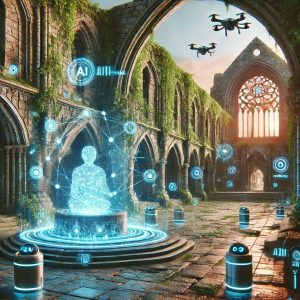Since the dawn of humanity nearly 200,000 years ago, humans have undergone very little evolutionary change. The brain, and therefore our psychology, wouldn’t be much different either; modern humans have the same psychological motivations as our caveman ancestors. It arises from the fact that our primary goal has always been and will always be to reproduce and pass on our DNA. However computers will transform the most, helping to revolutionize all aspects of our lives.
I already wrote a blog about (AI): Artificial Intelligence and many times you also hear the terms “Augmented reality” (AR) and “Virtual reality” (VR) but what are the differences and how do they impact our future?
Augmented and virtual reality have one big thing in common. They both have the remarkable ability to alter our perception of the world. Where they differ, is the perception of our presence. Virtual reality is able to transpose the user. In other words, bring us someplace else. Through closed visors or goggles, VR blocks out the room and puts our presence elsewhere. Putting a VR headset over your eyes will leave you blind to the current world, but will expand your senses with experiences within.
Augmented reality however, takes our current reality and adds something to it. It does not move us elsewhere. It simply “augments” our current state of presence, often with clear visors.
“I’m excited about Augmented Reality because unlike Virtual Reality which closes the world out, AR allows individuals to be present in the world but hopefully allows an improvement on what’s happening presently… That has resonance.”
Tim Cook, CEO, Apple
One of the most innovative Augmented Reality ADs – “Burn That Ad” by Burger King. And there are lots of more companies stepping into the AR era!
In the future, augmented reality systems will integrate these individual services and further empower consumers by allowing them to gather instant information about products, persons and places via the internet. Augmented reality systems put computer-generated images into your field of vision, so you can manipulate them by simply using your mind.
One example of such a device might be the Internet Lens, a stand-alone computer that is embedded in a contact lens and beams images directly onto your retina. This device would be able to access product reviews by scanning universal barcodes. It might also give you information and reviews on restaurants based on your GPS location.
Technology that simplifies our lives will always be successful. Smartphones, for example, simplify our lives by reducing the number of devices we need to carry around in order to stay connected to the web. Telekinetic technology will be the next leap in simplifying our lives by relieving us of the burden of having to move to interact with computerized devices.
Telekinesis – the power to move things with the mind – has long been part of the scifi tradition and of daydreaming fantasies. However, current advances in neuroscience are turning this fantasy into a reality.
In the future, we will be literally surrounded by computers we can interact with using telekinesis. In the home, these devices would all be integrated into a central controller with a telekinetic interface. Therefore, using the power of telekinetic technology, you could change the music in the living room or turn on your dishwasher, all without moving a muscle – you simply make a mental command, and, like magic, it is done.
Before the turn of the next century, our lives will already be so immersed in technology that the distinction between “artificial” realities and “real life” will no longer make sense. In fact, in many ways, this process has already begun.
For example, social networks allow us to connect with people exclusively over the internet. For many, the virtual profiles they create and the online communities they interact with feel no less “real” than their interactions with people in physical “real life.” All aspects of human interaction, from business to romance, are rapidly migrating to these online platforms.
In the far future, we will spend an even greater majority of our time immersed in digital realities, but there will be one crucial difference: the gateway to these artificial realities will no longer be hand-held devices but, rather, modifications to the body itself.
As our understanding of the human brain deepens, we will begin to see brain modifications, where computers are placed into the brain, or even replace parts of the brain. With these modifications, we will be able to access the Internet directly using only our thoughts, meaning the lines between “real” and “artificial” will become even more blurred. So, as we begin to replace our brains with sturdier, more powerful machines, we will more often interact in artificial worlds without the aid of a smartphone or laptop. The Internet and the digital world contained within will soon no longer be thought of as a service but as part of our reality.
Eventually, as this process continues, it might be possible to transfer our consciousness completely to a digital medium, thus transcending our human bodies and beginning a new age of humanity. (So maybe you dont have to tell your wife or husband that you want to divorce because your brain knows and sending the DATA – hmmm…)
View this post on InstagramA post shared by Soo-Me (@soo_me_social) on
Although we cannot know the future with 100% accuracy, there are tools we can use to at least make educated guesses about what sorts of technologies await us as we progress through the 21st century. The rapid acceleration of developments in computing, genetics, physics and biology promise technological advancements that were once thought of as mere science fiction.
Sounds a bit scary doesn’t it? Science Fiction is becoming a real thing.. Let me know what you think and share you thoughts:)
Love, Marietta


